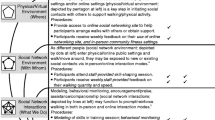Abstract
The purpose of this study is to observe the response of a group of subjects towards a message persuading them to include physical activities into their daily routine in order to improve and maintain their overall health. Our message, based on previous scientific studies, is in the form of short movie emphasizing that exercising during 2% of the day, or 30 min, is sufficient to remain in good health. The slogan, “What’s Your 2%?” is appealing because “2%” is perceived as such a tiny fraction, yet it accurately reflects the 30-minute daily exercise goal as recommended by experts. This study uses persuasive techniques applied to a group of subjects composed of members of our personal Facebook networks, and this social network platform as way to communicate with them. We were able to demonstrate that changing a person’s short-term exercise behavior is possible by using persuasive technology.
Access this chapter
Tax calculation will be finalised at checkout
Purchases are for personal use only
Preview
Unable to display preview. Download preview PDF.
Similar content being viewed by others
References
Jaslow, R.: CDC: 80 percent of American adults don’t get recommended exercise, http://www.cbsnews.com (May 3, 2013)
Serapio, N., Fogg, B.: Designing for video engagement on social networks: a video marketing case study, p. 1 (2009)
Got Milk?, Wikipedia, the free encyclopedia (November 6, 2013)
Chatterjee, S.: ACM Digital Library. In: Proceedings of the 4th International Conference on Persuasive Technology. ACM, New York (2009)
Services, H.: Two Thousand Eight Physical Activity Guidelines for Americans: Be Active, Healthy, and Happy. Government Printing Office (2008)
Lacroix, J., Saini, P., Goris, A.: Understanding user cognitions to guide the tailoring of persuasive technology-based physical activity interventions. In: Proceedings of the 4th International Conference on Persuasive Technology, New York, NY, USA, pp. 9:1–9:8 (2009)
WHO | Physical activity, WHO, http://www.who.int/topics/physical_activity/en/ (accessed November 11, 2013)
Dillard, J., Shen, L.: The Sage Handbook of Persuasion: Development in Theory and Practice, 2nd edn. Sage, Los Angeles (2013)
Fogg, B.: Persuasive Technology: Using Computers to Change What We Think and Do. Morgan Kaufman Publishers, San Francisco (2003)
Edward, R., Laskowski, M.D.: Exercise: How much do I need each day?, http://www.mayoclinic.com/health/exercise/AN01713
Consolvo, S., Klasnja, P., McDonald, D.W., Landay, J.A.: Goal-setting Considerations for Persuasive Technologies That Encourage Physical Activity. In: Proceedings of the 4th International Conference on Persuasive Technology, New York, NY, USA, pp. 8:1–8:8 (2009)
Locke, E.A., Latham, G.P.: Building a practically useful theory of goal setting and task motivation: A 35-year odyssey. American Psychologist 57(9), 705–717 (2002)
Fogg, B.: Behavior Grid, http://www.behaviorgrid.org/ (accessed November 15, 2013)
Author information
Authors and Affiliations
Editor information
Editors and Affiliations
Rights and permissions
Copyright information
© 2014 Springer International Publishing Switzerland
About this paper
Cite this paper
Clinkenbeard, D. et al. (2014). What’s Your 2%? A Pilot Study for Encouraging Physical Activity Using Persuasive Video and Social Media. In: Spagnolli, A., Chittaro, L., Gamberini, L. (eds) Persuasive Technology. PERSUASIVE 2014. Lecture Notes in Computer Science, vol 8462. Springer, Cham. https://doi.org/10.1007/978-3-319-07127-5_5
Download citation
DOI: https://doi.org/10.1007/978-3-319-07127-5_5
Publisher Name: Springer, Cham
Print ISBN: 978-3-319-07126-8
Online ISBN: 978-3-319-07127-5
eBook Packages: Computer ScienceComputer Science (R0)




